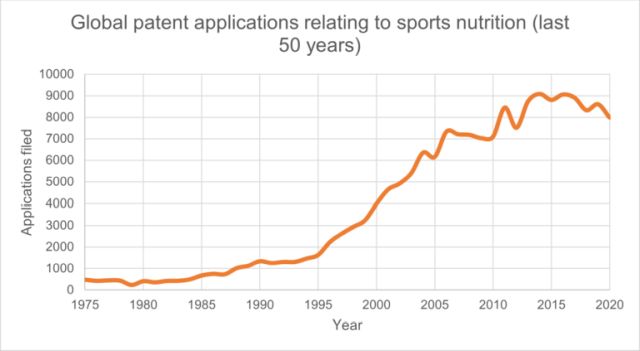The importance of innovation in sporting success
With the Euros in full swing and the Olympics on the horizon, this summer elite athletes will be pushed to the limits of their physical and mental capabilities in pursuit of gold. The winning formula will not only depend on talent and years of training, but also on modern products which allow athletes to push harder and recover faster. If a product offers a tangible athletic advantage, it catches on quickly and may even be seen as an essential piece of kit. Therefore, companies that develop these innovations stand to gain significant market share.
An infamous example of innovation in the running world is the Nike Vaporfly super-shoe. When Nike released their first carbon-plated shoe, it was so popular that athletes sponsored by other brands were found to be wearing disguised versions of the shoe. There was no alternative.
Kara Goucher, an athlete who missed out on the 2016 Olympics while competing against others with the new shoes, was quoted as saying:
"Not all athletes like the idea of a propulsion device on their foot, but they can't cede three to six minutes in a marathon in elite competition."
While technology in shoes and other kit has certainly had a big impact, the technology behind food (or 'fuel') is also full of innovation, and associated IP.
In the early 1900's it was believed that eating and drinking during an endurance event would provide no benefit and cause stomach upset. When they did drink, athletes were often given whiskey or brandy shots instead of water! (a wonderful example of wacky hydration and nutrition practices of the time is the story of the 1904 Olympic marathon.)
Modern hydration and nutrition for athletes only started to take off in the 1960s. In 1965, the sports drink Gatorade was developed in collaboration with the University of Florida's football team. Gatorade was designed to replace carbohydrates and salts which players lost during games. A few years later, after a defeat to the Florida Gators, the coach of the Georgia Tech Yellow Jackets was quoted as saying:
"We didn't have Gatorade. That made the difference."
The success of products like Gatorade led to more focus on the science behind nutrition and laid the foundation for the wide variety of products available today. Modern athletes have a whole range of food and drink options for before, during, and after their event. As evidenced by Gatorade and Nike, if a brand creates a product which provides a real advantage, they stand to gain significantly. This is especially true if the product is suitably protected with a combination of patent and trade mark filings.
Trends in sports nutrition IP
As recognition of the importance of sports nutrition has grown, innovation in these areas has accelerated, leading to increased patent filings.

Figure 1. Annual patent applications with the International Patent Classification (IPC) code A23 (food) which contain the term "sport(s)" in the description.
Figure 1 shows the trend in patent applications filed globally for inventions relating to food products for use in sport. The activity in this area surged in the early 2000s, and now thousands of patent applications are filed annually for new sports nutrition products.
The inventions described in these patent applications relate to a huge range of nutrition and hydration formulations. This diversity of products highlights how advancements in technology play a crucial role in providing nutritional support for all athletes. For example, protein supplements may be designed for weightlifters while carbohydrate mixes are targeted at endurance athletes.
Endurance athletes have unique nutritional needs compared to other athletes because, to perform at their best, they need to eat during their events. Additionally, because they consume a significant amount of food during their events, small advantages can have a longer-lasting impact on their performance.

Figure 2. Top 40 filers of patent applications for inventions with IPC code A23 (food) which contain the terms "sport(s), performance, athlete and endurance" in the description.
Figure 2 shows the main companies that are generating IP relating to food products for athletic performance with a focus on endurance. Among the most active patent filers are large multinational companies, such as Nestlé, Premier Nutrition, and Nutricia. However, we also see that smaller companies and universities have been making use of patent protection.
Amongst the list in Figure 2 are companies that produce some of the most recognisable energy gels, drinks, and chews used by endurance athletes. These brands include SiS Science in Sport and Laminaria Group AB (Maurten gels). We take a closer look at the patent portfolios of these companies in the following case studies.
Case Study 1: SiS Science in Sport LTD
Science in Sport (SiS) is a well-known company in the performance nutrition market. They develop energy gels, energy chews, electrolytes, protein powders, and carbohydrate drink powders. Founded in 1992, SiS began manufacturing sports supplements on a small scale. However, as athletes and coaches became more conscious of the small performance gains provided by specially formulated 'fuels', the brand grew quickly. In the 2020 Olympics, 74 medal-winning athletes or teams used SiS products.
One of their most recognisable products is their isotonic gel. This gel was the first to be formulated such that there was no need to consume it with additional water. The gel itself, and methods for making the gel, are protected by European patent EP1981359B1.
SiS also make use of trade mark protection, having registered 13 trade marks in the UK. They have protected their word marks SCIENCE IN SPORT, SiS, SIS, and their figurative logo mark. They have also protected the branding used on their products, such as GO GEL, GO ENERGY, and GO ELECTROLYTE. SiS are now a highly trusted brand used by elite athletes. Registered trade mark protection has helped SiS to protect and maintain their hard-earned reputation.
SiS have achieved success by consistently updating their current products to keep them relevant. By utilizing both patent and trademark protection, SiS have solidified their position as a key player in a competitive market.
Case Study 2: Maurten
Maurten, founded in 2015, has quickly become known as a premium brand in the performance nutrition market.
Their first patent, filed in 2016, describes a hydrogel-based supplement made from alginate and pectin for use as a sports gel. The hydrogel encapsulates carbohydrates, allowing athletes to consume large amounts of carbohydrates without causing gastrointestinal distress.
Maurten's gel formulation provides an excellent example of how companies innovate in parallel with academic research. The ratio of carbohydrates described in the patent has been shown to be optimal for enhancing athletic performance (Medicine & Science in Sports & Exercise 45(9), 1814-1824, September 2013). The gel also contains a higher overall density of carbohydrates, in line with research indicating that athletes should consume 90 to 120 grams of carbohydrates per hour during prolonged exercise. This highlights how academic research findings can pose technical challenges for manufacturers seeking to put them into practice. In turn, these challenges provide opportunities to innovate and create new products which match the latest guidance on nutrition.
Maurten has also innovated in other areas of sports nutrition, one example being their sodium bicarbonate system.
Traditionally used in short-distance races, e.g. 800m, sodium bicarbonate is a supplement which athletes take before an event. The goal is to neutralize lactic acid in the bloodstream that is generated during exercise, enabling athletes to push harder before hitting an acidosis-related wall. However, ingesting sodium bicarbonate often leads to gastrointestinal distress as it reacts with stomach acid. Maurten set out to solve this problem.
As described in their latest patent filing, WO2023025806A1, Maurten uses their hydrogel technology to encapsulate the bicarbonate, allowing it to bypass the stomach and release directly into the intestine. This provides high doses of bicarbonate without gastrointestinal side-effects.
This sodium bicarbonate innovation highlights that there are opportunities for improving upon known products and that these improvements can result in valuable IP.
Returning to the examples of the Nike Vaporflys and Gatorade, if athletes who use Maurten's bicarbonate system are able to push harder and for longer before reaching exhaustion, they will have an advantage. If this advantage is significant it could become established as an essential part of professional athletes' pre-event nutrition. Crucially, this can then be seen by potential consumers who want to try and improve their own sporting performances.
Further to their patent application filings, Maurten have created a distinctive and premium-looking brand identity, projecting a Silicon Valley energy with modern branding and slick designs. Not only does this make a brand memorable, it represents another area that can be protected using registered IP, adding to the company's assets.
Conclusion
The field of endurance sports nutrition is undeniably competitive, as evidenced by the large number of recent patent filings. Companies such as SiS and Maurten have developed a successful strategy of continuous innovation based on a solid scientific foundation, while using a combination of patents and trade marks to protect their technology and carve out a strong reputation. These companies have proven that smaller players can be just as effective at establishing themselves in the marketplace as multi-national companies.
Any company in the sports nutrition space needs to ensure that steps to capture and safeguard innovative ideas are in place in order to gain an advantage in this competitive landscape.
The content of this article is intended to provide a general guide to the subject matter. Specialist advice should be sought about your specific circumstances.



